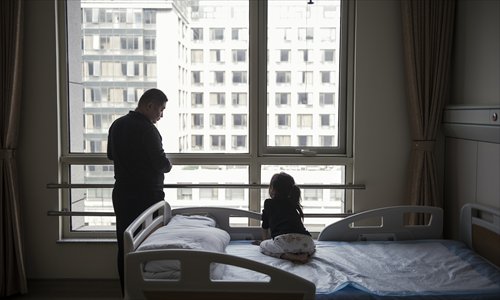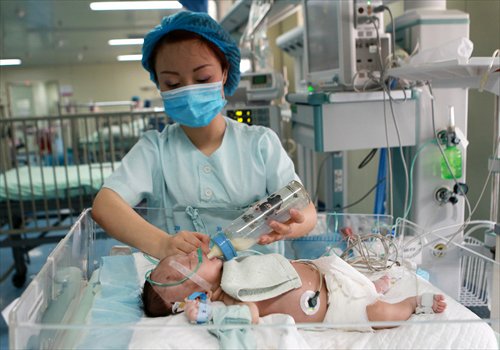Fighting child cancer
Malignant tumors in infants are often curable, but support from Chinese health system leaves much to be desired

According to the World Health Organization, the incidence of childhood cancer globally is around 160,000 new cases each year. Photo: Li Hao/GT
When Jin Huizi took her 11-month-old daughter Niu Niu (pseudonym) to the Beijing Children's Hospital in June, it was only supposed to be for a common cold.
Instead, Niu Niu was made to undergo an ultrasound scan, after the doctor noticed that the infant girl's stomach was abnormally swollen.
"The examination revealed that there was a large, unknown tumor in my daughter's abdominal cavity," said Jin.
Jin was required to go back to the hospital on the following day. After further tests, Niu Niu was diagnosed with hepatoblastoma, a rare liver cancer that occurs only in children, usually in the first three years of life.
Jin and her husband were distraught. Both had led healthy lives, so it was unimaginable to them that their daughter could have cancer. They were told that cancer in infants usually spread much more rapidly, progressing from early stage to late stage within a period of three months.
Fortunately for them, the cancer was discovered early. There was still hope that their girl would survive.



Some of the problems facing childhood cancer patients in China are misdiagnosis, a lack of ideal medicine, and the high cost of treatment. Photos: CFP, Li Hao/GT
The facts about childhood cancer
According to an informational package published by the World Health Organization (WHO) in 2009, there are around 160,000 new cases of cancer discovered in children (under the age of 15) every year, and 90,000 deaths in children resulting from cancer.
The report goes on to list a number of qualitative differences between cancer in children and adults, based on the fact that children are exposed to different environmental factors, and that their physiology, which has not yet matured, will respond differently to environmental factors.
"Children can not be diagnosed and treated as if they were just little adults," said Wang Jiayi, a doctor in the oncology department of Guangzhou Women and Children's Medical Center.
As for the causes of childhood cancers, the WHO report identified familial and genetic factors and known environmental factors as accounting for up to 25 percent of cases.
The causes for the other 75 percent of cases is currently unknown, although ongoing studies have speculated that exposure to chemical substances, heavy metals, and types of radiation not currently known to be linked to cancer could be contributing risk factors.
Despite the failure to attribute the majority of cases of childhood cancer to a known cause, the efficacy of treatment in developed countries is quite high.
According to the American Childhood Cancer Organization, the overall five-year survival rate for childhood cancer is 80 percent in the US.
The situation in China
Deng Qinghua, director of radiology at the Hangzhou Cancer Hospital, said in comments made to the Today Morning Express in November that the incidence of childhood cancer in China has risen from about 1 out of every 10,000 children in the 1980s to 2.13 out of every 10,000 children.
Each year, 60,000 to 70,000 children are diagnosed with cancer in this country, according to the report.
Treatment of child cancer in China however, said Wang, remained hampered by poor medical infrastructure.
"At the moment, in China, the resources and infrastructure for treating childhood cancers is rather poor," said Wang. "Because there's no medication in China that has been made specifically for children, treatment consists of a reduced dose of medication that is meant for adults. There is a drastic lack of funding, specialized hospitals and specialist doctors."
A report published in October in the Dahe Daily noted the shortage of oncology departments in general hospitals, which meant that such hospitals would frequently turn away children diagnosed with cancer due to an inability to adequately treat them.
Jin, who signed up to a number of online support groups after her daughter's diagnosis, said that another common problem was a lack of understanding about childhood cancer. "[Often], the initial symptoms are common things like fever or stomachache, and it never occurs to parents that their child might have a tumor," said Jin.
"To save more children from dying of malignant tumors, our country needs to pay more attention to these little patients," said Wang. "The government, hospitals, and the health sector all need to do their part."
Missed detection and misdiagnosis
Xia Zhidong, the father of a 2-year-old boy who like Niu Niu has been diagnosed with hepatoblastoma, said he was initially told by doctors at a Beijing hospital that his son was suffering from an intestinal obstruction.
"I took my son to see five different doctors, but none of them were able to give the correct diagnosis," said Xia. As time passed without a correct diagnosis being made, Xia's son's condition worsened.
"My son is now in intensive care, with a serious infection and his belly swollen," said Xia. "It wasn't until a specialist group consultation that the correct diagnosis was made."
Wang said that misdiagnosis of childhood cancer patients was common in China.
"Not only do most parents never consider that their child might have cancer, most hospitals without child oncology departments make the same mistake during diagnosis. It does not occur to a lot of doctors that a child might have a tumor," said Wang.
One of the other factors that contributed to poor early detection rates of childhood cancers, said Wang, was the fact that young children lacked the linguistic competency to explain their symptoms. Consequently, it was only when the symptoms had become severe, during the late period of cancer, that it would be correctly diagnosed.
"The misdiagnosis delays treatment," said Wang. "Even worse, if a doctor prescribes the wrong treatment at an early stage of the tumor, it can lead to a much lower efficacy rate [when the right treatment is prescribed]."
In the Dahe Daily report, some doctors suggested that mandatory screening procedures for childhood cancer be implemented in Chinese hospitals.
"In Japan, children under the age of one have to undergo a compulsory medical examination for malignant tumors," said Liu Wei, director of the child oncology department at the Children's Hospital of Zhengzhou, Henan Province.
"Most tumors can be detected during pregnancy, and an early checkup after the child is born means that any cancer can be discovered at the earliest possible moment, which raises the likelihood of [effective treatment]."
In the absence of mandatory screening, Yan Jie, director of the child oncology department at Henan Cancer Hospital, advised parents to be vigilant in the same report.
"If your child has a fever lasting more than one week and his or her lymph nodes are swollen, or if his or her growth abruptly slows down or he or she starts shedding weight, you should take your child to the hospital for examination," said Yan. "When bathing or massaging the child, caretakers can also pay attention to whether there are unknown lumps on the child's stomach and limbs."
The cost of treatment
Even if childhood cancer is detected earlier and it is treatable, one of the biggest hurdles facing parents who want to see their child cured is the cost of treatment.
"[I read about] a 1-year-old girl from a poor family in the rural area in Hunan Province who was diagnosed with neuroblastoma [a common childhood cancer]," said Jin.
"The family was told that treatment may cost more than 500,000 yuan ($80,694.61), which they couldn't afford."
In the Dahe Daily report, Yan said that such cases were not uncommon, which was all the more heartbreaking in light of the fact that, in most cases, early treatment could extend the child's life.
"Generally speaking, about two-thirds of children with cancer can be treated," said Yan. "[In some cases], the cancer will go into complete remission, and they will be able to live a normal life."
Jin was told by doctors that the efficacy rate of treatment on her daughter's illness was 70 percent. To pay for the cost of treatment, Jin and her husband have decided to sell their house in Beijing.
"Since we are busy with our daughter's disease, my parents, who are both over 70, have just finished helping us go through the paperwork to sell our house," said Jin.
"We have no other choice. The doctor said there's hope that my daughter can be cured, so our family will spare no effort to save her life," Jin said.
Newspaper headline: Malignant tumors in infants are often curable, but support from Chinese health system leaves much to be desired